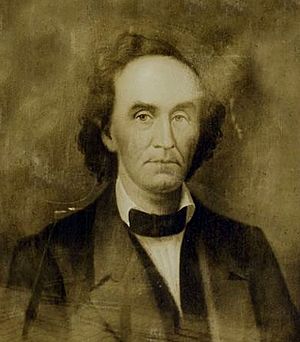Claiborne Fox Jackson facts for kids
Claiborne Fox Jackson (born April 4, 1806 – died December 6, 1862) was an important political leader in Missouri. He became the 15th governor of Missouri in 1861. He supported the Confederacy during the American Civil War. Jackson was governor for only five months. He was removed from office on June 15, 1861. After this, he went to Arkansas and joined the Confederacy. He passed away in 1862.
Contents
Early Life and Moving West
Claiborne Fox Jackson was born on April 4, 1806. His family lived in Fleming County, Kentucky. His parents were Dempsey and Mary Jackson. They were tobacco farmers. They also owned many slaves.
In 1826, Jackson moved to Franklin, Missouri. This town was the start of the Santa Fe Trail. This trail was a key route for trading with Mexico. Even though many areas were struggling, Franklin was growing fast. Jackson and his older brother opened a store there. Many new people in Franklin came from the South. They brought their slaves with them. These new settlers started farms along the Missouri River. This area became a center for slavery in Missouri.
Jackson's Political Journey
In 1836, Jackson started his political career. He represented Saline County, Missouri in the Missouri House of Representatives. From 1838 to 1842, he worked at the state bank in Fayette, Missouri. He was elected to the state House again in 1842. This time he represented Howard County, Missouri.
He served as the Speaker of the House in 1844 and 1846. The Speaker leads the meetings of the House. In 1848, he was elected to the Missouri State Senate. He returned to the House of Representatives in 1852. From 1857 to 1860, he was a state bank commissioner. In 1860, he became the Democratic candidate for governor. He won the election and became governor on January 3, 1861.
Governor During the Civil War
Jackson won the election by acting like a moderate leader. But he soon showed strong support for slavery. After Abraham Lincoln became President of the United States, Jackson tried to get Missouri to leave the Union.
When Fort Sumter was attacked in April 1861, Lincoln asked for volunteers. He wanted 75,000 soldiers to stop the rebellion. Governor Jackson refused to send troops from Missouri. Instead, he asked for 50,000 volunteers to defend Missouri against the Union. Jackson secretly tried to get artillery weapons for his state militia from the Confederates.
The most important place in Missouri was the federal arsenal in St. Louis. An arsenal is a place where weapons are stored. Only a small group of Union soldiers guarded it. They were led by Captain Lyon. But Lyon had already moved most of the gunpowder and weapons to safety in Illinois. The U.S. Secretary of War also told Lyon he could raise more Union soldiers.
On May 6, Jackson sent his militia to camp near St. Louis. He hoped to get the Union soldiers' weapons. But on May 10, Lyon marched 6,500 Union troops to the camp. They surrounded the militia and arrested them all. This event was called the Camp Jackson Affair. After this, Lyon was promoted to Brigadier general. He took charge of all Union forces in Missouri.
On June 13, 1861, talks between Governor Jackson and Lyon failed. Lyon quickly moved his army to attack the pro-Confederate forces. They were in Jefferson City, Missouri, the state capital. Lyon moved so fast that he surprised them. On June 15, the Union Army took over Jefferson City. Jackson and most of his militia went to the southwest part of Missouri. Lyon then set up a pro-Union government. He then moved his army to chase the rebels. On June 17, they fought the Battle of Boonville. It lasted only about 30 minutes. The Union forces easily defeated the pro-Confederates. Jackson watched the battle and then retreated with his militia.
Battle of Carthage
Jackson and about 4,000 of his militia fled to Carthage, Missouri. His troops were not well-trained or well-armed. Lyon had split his forces to find Jackson. He sent Colonel Franz Sigel with about 1,000 soldiers to southwest Missouri.
On July 4, Jackson learned that Sigel was camped at Carthage. The next day, Jackson led his militia to attack Sigel's smaller Union force. The battle line was about ten miles south of Carthage. Jackson waited for Sigel to attack first. Sigel started the battle with artillery fire. He then attacked Jackson's militia. However, Sigel saw a large Confederate force moving around his left side. He pulled back to avoid being surrounded. He did not know that this force was mostly unarmed militia. Sigel fought a good rearguard action as his small army moved back to Carthage. He then retreated to Sarcoxie, Missouri. This battle did not change much. But it gave hope to the pro-Confederates in Missouri. It was their first reported victory. Jackson was the only sitting governor to lead troops in a battle.
Later Life and Death
After the battle, Jackson still believed he was the governor. He called a special meeting of lawmakers in Neosho, Missouri. This meeting happened on October 28, 1861. Even though he was removed from office, he officially declared that Missouri had joined the Confederacy in November 1861.
Jackson was given the rank of Brigadier general in the Confederate Army. But he soon resigned because he was very sick. On December 6, 1862, Jackson died in Little Rock, Arkansas. He had stomach cancer. He is buried in the Sappington family cemetery in Arrow Rock, Missouri.
Images for kids
-
Jackson's Tomb in the Sappington Cemetery, Saline County, Missouri



